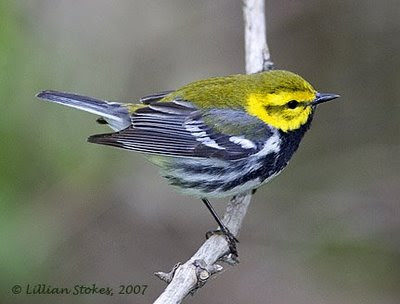
Black-and-white Warbler

Prairie Warbler
Warblers are beginning their migration. We had fun this morning, searching our property for early moving warblers. Fall warbler watching is different and more nuanced than spring. Males are not singing conspicuously from perches on their breeding territories. Instead, you have to watch for movement in bushes and listen carefully for the different little chip sounds each warbler species makes. In addition, some warbler species change from their bright breeding plumage into more sublte colors.
Recently we saw a Black-and-white Warbler. This morning we saw a Prairie Warbler, Chestnut-sided Warbler and two Common Yellowthroats. People often don't realize you can see migrant warblers as early as August. Warbler migration can extend into October and beyond.
From our
Stokes Field Guide To Warblers here's a list of which warblers to be on the look-out for. Dates refer to the
earliest times these birds may move, when the first birds start to migrate south, obviously there is overlap in their migration:
For the EastEarly (Begins before 8/1)Cerulaean Warbler
Hooded Warbler
Louisiana Waterthrush
Prairie Warbler
Worm-eating Warbler
Middle (Begins between 8/1 and 8/20American Redstart
Black-and-white Warbler
Blackburninan Warbler
Blackpoll Warbler
Black-throated Green Warbler
Blue-winged Warbler
Canada Warbler
Kentucky Warbler
Magnolia Warbler
Mourning Warbler
Northern Parula
Northern Waterthrush
Prothonotary Warbler
Swainson's Warbler
Tennessee Warbler
Wilson's Warbler
Yellow-breasted Chat
Yellow-throated Warbler
Late (Begins after 8/20)
Bay-breasted Warbler
Black-throated Blue Warbler
Cape May Warbler
Chestnut-sided Warbler
Common Yellowthroat
Connecticut Warbler
Golden-winged Warbler
Nashville Warbler
Orange-crowned Warbler
Ovenbird
Palm Warbler
Pine warbler
Yellow-rumped Warbler
For the WestEarly (Begins before 8/1)Colima Warbler
Golden-cheeked Warbler
Hermit Warbler
Lucy's Warbler
Yellow Warbler
Middle (Begins between 8/1 and 8/20)American Redstart
Black-throated Gray Warbler
Common Yellowthroat
Grace's Warbler
Nashville Warbler
Orange-crowned Warbler
Red-faced Warbler
Townsend's Warbler
Tropical Parula
Virginia's Warbler
Wilson's Warbler
Yellow-breasted Chat
Late (Begins after 8/20)MacGillivray's Warbler
Olive Warbler
Painted Redstart
Palm Warbler
Yellow-rumped Warbler
Birding is often about knowing who to look for when. If you have a sense of this, you will be much more likely to see interesting birds and expand your horizons about the complex lives of these beautiful warblers we share the planet with.
 Last night we saw 169 Common Nighthawks migrating over our property in NH. Fortunately, our property fronts on a pond that is a dammed up part of a river that runs south to north and nighthawks often migrate along river corridors. So, we are in a very good spot for seeing migrating nighthawks. At about 5 pm we got ourselves stationed on our deck with binoculars and from 5-5:30 pm saw 81 nightawks. We realized making dinner would be a challenge, so we tag-teamed grilling the burgers, one of us always scanning through our binos. We ate dinner with one hand holding the burger, the other hand holding the binos. In the next half hour 54 more nighthawks came, then 34 more over the next hour and a half. We ended at 7:30 pm. Very rewarding to see these unusual birds whose numbers seem to be dropping. Tonight we'll be watching again.
Last night we saw 169 Common Nighthawks migrating over our property in NH. Fortunately, our property fronts on a pond that is a dammed up part of a river that runs south to north and nighthawks often migrate along river corridors. So, we are in a very good spot for seeing migrating nighthawks. At about 5 pm we got ourselves stationed on our deck with binoculars and from 5-5:30 pm saw 81 nightawks. We realized making dinner would be a challenge, so we tag-teamed grilling the burgers, one of us always scanning through our binos. We ate dinner with one hand holding the burger, the other hand holding the binos. In the next half hour 54 more nighthawks came, then 34 more over the next hour and a half. We ended at 7:30 pm. Very rewarding to see these unusual birds whose numbers seem to be dropping. Tonight we'll be watching again.
















